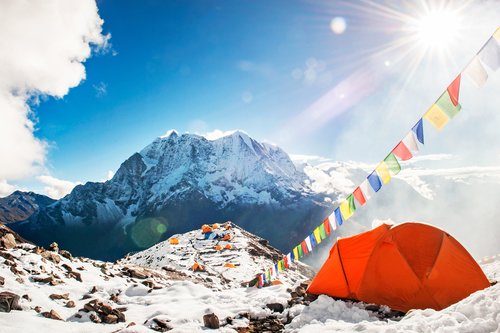Everest Base Camp Temperature and Weather in January

Think again if you believe that it is impossible to trek to Everest Base Camp in January! We are here to tell you that it is not only feasible but also one of the highest points of adventure in trekking. One of the many exciting experiences that nature lovers and adventure seekers throughout the world do not want to miss is trekking to the foot of the highest mountain peak in the world. And if you’re willing to push yourself even farther, the Everest Base Camp (EBC) trip in January is by far the most exhilarating experience you could have.
Why is trekking especially an exciting achievement in January? To begin with, January is Nepal’s busiest winter month. Typically, the Himalayas are far colder than the typical Nepali landscape. The most difficult weather is experienced in the Himalayas in January, with very cold winds and copious amounts of snowfall. But even in January, the sun is still beaming brightly. However, a lot of snow can obstruct your way, satisfying the cravings of your adrenaline-seeking spirit.
Although the Everest region is undoubtedly one of the most breathtaking natural wonders of the planet, there is something more alluring about it in January. The extreme of extremes is trekking in the upper Himalayas in January. In the severe winter weather, the Everest region offers a different setting along the routes of Kala Patthar and the base camp. The area is adorned with colorful foliage in the spring, and you may see a picture-perfect atmosphere in the fall; yet, January will bring with it opposing aspects.
January is a white month. There’s not a snow-free inch of ground in sight. The sky is cloudless, but brilliant with sunrays reflecting the snow. It is, therefore, a really strange feeling. It may seem like you are somewhere trying to reach the top of a mountain. You may experience what it could be like to finally attempt to conquer the Himalayan peaks by going on the January trip to Everest Base Camp.
It’s important for you to take many safety precautions when trekking in January. The month experiences the lowest average temperature and the coldest weather of all the seasons. Thus, you have to pack really carefully. You need to wear additional insulating clothing and layer yourself. In a similar vein, you also need to consider the gear you’ll bring.
Are you still worried? Don’t worry! We’re here to go over what you need to know about trekking in the Everest region in January. It’s a fun walk in January for the most courageous. Everything relies on how you organize your travel. Now, let’s learn more about the Everest Base Camp trek in January.
Highlights of January Trekking to Everest Base Camp
- Magnificent vista of Mount Everest Unclouded skies offering the most breathtaking vistas of dawn and dusk
- Gorgeous scenery blanketed in snow all around
- More choices for accommodation and food
- Simple access to Lukla flights
- Unused paths for pleasant hiking
- Celebrating the New Year with the local Sherpas
- An amazing trekking adventure for experienced hikers
What’s the weather and temperature at Everest Base Camp like in January?
Because it is located in the upper Himalayas, the Everest region is always colder than its neighboring regions. However, the Himalayan winter season makes up for the lowest annual temperature experienced in the area. The region also sees an increase in snowfall starting in the middle of winter, which blankets the pathways in snow. Nearly every mountain and hill in your immediate area is blanketed in snow.
Likewise, you may even experience strong winds blowing through you, sending shivers down your spine. Positively, your journey will be remarkably sunny as the sky is clear and cloudless during the day. It’s imperative to pack warmer clothing if you want to shield yourself from the icy weather. A once-in-a-lifetime adventure, the winter hike in the Everest region offers breathtaking views of mountains and powder blue lakes.
Since it doesn’t rain much in the Nepalese Himalayas, January will offer clear, crisp skies and the greatest views of the mountains. On the other hand, snowfall is always possible at high elevations. When walking on deep snow, it is best to have crampons and a set of trekking poles with you. The days are sunny and unexpectedly warm in January. On the other hand, severe winds and blizzards should be avoided.
The average January temperature at Namche Bazaar, at an elevation of 3440 meters, varies from 18 to 43°F (-8 to 6°C). The higher you go, the lower the temperature gets. The Everest Base Camp sees nighttime lows of between -5 and -12 degrees Celsius in January. It’s not all that horrible. To put things in perspective, even on the coldest evenings in Kathmandu, when temperatures drop to 1-2 degrees Celsius, people remain warm and comfortable. Therefore, if you bring thick clothing and sleeping bags, you’ll feel fairly toasty even at night. It gets as high as 10 degrees Celsius during the day, which is rather comfortable.
Why trek to Everest Base Camp in January?
Since January is the off-season, there aren’t many good reasons to visit EBC during this month. However, it’s the best month ever for real adventurers. A January hike to base camp has a few benefits if you’re accustomed to the unadulterated outdoors and want to experience the thrill that few others dare.
Cloudless Skies and Magnificent Himalayan Panorama
The majority of January had cloudless skies. Thus, you will be able to enjoy the splendor of the expansive Himalayan landscape. Your path will be accompanied by the Himalayas the entire time. They’ll feel closer to you as you rise higher. It’s one of those emotions that words just can’t express. To top it off, Tengboche’s neighboring mountains are stunning and alluring. The EBC Trek route passes through several breathtakingly gorgeous and thrilling locations.
Peaceful Trail
January is the month when trekking is least popular. This implies that the trail will be all yours. Trekking is a fantastic adventure that you can enjoy alone. You can just walk wherever you like without having to consider the crowd. By alone, you can enjoy the peace and admire the beauty. Less individuals can also take advantage of the tea house’s benefits. You can strike up a conversation and even ask them specific questions you have.
Easy Getting Flights
Off-season trekking has advantages. Purchasing tickets for a flight to and from Lukla is not a concern. Tickets are always available, therefore reservations are not necessary. During the off-season, flights to Lukla are mostly empty, which is not possible during the busiest season. If you have been to Lukla in the fall or spring, you will understand why buying Lukla tickets might be stressful. Consequently, purchasing a ticket in January is far less stressful. In addition, the clear early sky reduce the likelihood of flight disruptions.
Ample Accommodation Facility
Finding your ideal accommodation in the Everest region can be difficult in the autumn and spring, but in the winter, most teahouses and lodges will be quieter and have more rooms available. Trekking season’s high is when the lodges and teahouses are full of hikers. However, you may put off making reservations as early as January and feel secure about finding lodging. Since there won’t be many people and there will be plenty to share, you can also ask for additional blankets. You can also receive savings on lodging and food.
January Festivities
A hike over the Everest region might make for the most amazing New Year’s Eve celebration! Why not make December 31st, Namche Bazaar, a visit? It allows you to see the bars and nightlife of the upper Himalayas as well as take part in the local festivals. What a wonderful way to begin the new year!?
Similarly, Lhosar is a celebration that happens in January sometimes, but not usually. This Buddhist festival is very important to Nepali ethnic groups that have connections to Tibet, especially the Gurung, Tamang, and Sherpa people. You may see some celebrations in the Khumbu region if you come during Lhosar. Alternatively, plan your vacation around the Lhosar festival to enhance your cross-cultural encounters while traveling.
What are the major concerns about trekking to EBC in January?
The journey to reach Everest Base Camp is already difficult. January is especially hard because of the consequences of the severely cold mid-winter weather. Here are some issues you can run into when trekking to EBC in January. Spend some time learning about them so that you can address them effectively.
Snowfall and Blockade
Higher up, there will be places where the drifts of snow are quite deep. It may thus be necessary for you to make your way through heavy snow. It’s possible for the trails to get snow-covered. Pay attention to what your advisors advise you to do during these times. If not, there’s a chance you could get disoriented and miss your destination. Walking in snowy weather might also benefit from having a pair of crampons with you. Using crampons can help you stay balanced and anchor yourself in the snow.
Blizzards and Bitter Cold
One of the biggest challenges you’ll face on your January trek to Everest Base Camp is a blizzard. Because of the cold wind, the area around Mount Everest may encounter bad weather, including blizzards. When the weather is too harsh, it is preferable to stay inside and stay informed about weather forecasts for added safety.
Possibility of Frostbite
In January, the Everest region experiences severe cold. You have to understand how crucial it is to get the appropriate hiking gear. Make it a practice to layer your clothes. It’s important to wear layers, especially at night. Since insulating rooms is not a common practice in Nepal, you will need to wear layers of clothing. It’s important that you properly dress to prevent frostbite. Try not to show off too much of your skin.
Getting Stuck
It can snow a lot in January, sometimes to the extent that mountains of snow seem to be building up every minute. If there is too much snow on the ground, it may require you to stay overnight in the teahouses as it could hinder your way. Be careful to plan on a few additional days. Trekking in the Himalayas may be unexpected, particularly during the winter months. Adding extra days to your schedule is a great way to position yourself for success.
Solo Trekking
Most of the trails are completely covered with snow throughout the winter. Consequently, if you travel alone, you could get lost. In January, when there is an abundance of snow on the paths, it is very forbidden to go on a solo walk. Employ a knowledgeable hiking leader who has led parties in the area and is familiar with the route.
Is it necessary to hire guides and potters for the January trek to EBC?
Similarly, porters handle your bulky luggage for you. Your necessities will weigh more in January because of extra clothing, trekking equipment, and other goods. You don’t want to be completely worn out while hiking, do you? In order to make your tough January trekking expedition a little more comfortable, hire a guide and a porter.
In a similar vein, porters take care of your heavy bags. January will be a heavier month for you because of additional clothing, hiking gear, and other items. While hiking, you don’t want to be totally exhausted, do you? Hire a guide and a porter to provide a little extra comfort to your arduous January trekking excursion.
Tips for the Winter Trekking to Everest Base Camp
- Bring along winter hiking essentials such as down coats, trekking poles, heavy sleeping bags, and crampons. You wouldn’t believe how helpful they are.
- It’s imperative to dress in layers. Instead of wearing one heavy jacket, layer many lighter woolen items that you may take off over the day.
- Double-check everything you brought on your hike. You can buy everything you might have forgotten in Kathmandu before starting your climb.
- Check the status of your trip insurance policy. We advise you to purchase insurance that covers rescue and emergency evacuation.
- Have a few days of leeway on hand. When the weather goes bad, you can find yourself stuck in the mountains at any time. That means an additional few days will
- keep your expensive return ticket from being canceled.
- Regardless of the weather, make sure you are getting enough water. For a difference, try alternative drinks like garlic soup, ginger tea, or others instead of just plain old water.
- Trek with a reliable and respectable travel company. In the worst case scenario, their experience in the Himalayas will come in handy. They also hire porters and guides with a lot of training.
We hope that our blog has given you a new perspective on the Everest Base Camp journey in January. It would be ideal if, before to starting any trekking adventure, you conducted your own study. If you’d like to book the expedition with us, we’d be happy to help. You can expect an amazing, risk-free, and enjoyable trekking adventure in the Everest region thanks to the knowledge and twenty years of experience of our team in the Himalayas.




